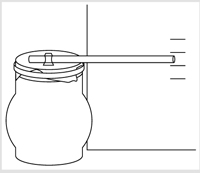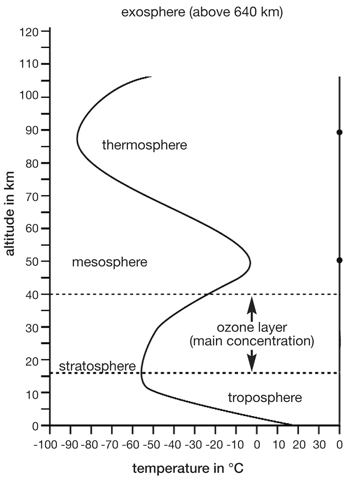![]()
WE CAN’T TOUCH it, we can’t smell it, but it’s all around us and it’s vital to our survival: it’s the Earth’s atmosphere. The atmosphere is our planet’s comfort blanket, regulating its temperature and protecting it from radiation. When we gaze up into its blue vastness, it may not seem as if much is going on there, but don’t be fooled – it’s a busy place where the constant but invisible interaction of natural forces creates our changing weather.
One clue to the nature of the atmosphere may be found in the word itself. Head for your nearest dictionary and you will see that it is derived from the Greek words atmos (vapour) and sphaira (sphere). In other words it’s just a great big bag of gas. In fact, the atmosphere is made up of a number of gases that together constitute what we call ‘air’.
The oldest gases in the atmosphere include carbon dioxide, nitrogen, methane, and the so-called ‘noble gases’ such as helium and argon. Water vapour has been there a long time too. But it wasn’t until the appearance of primitive bacteria, millions of years ago, that the vital component of the air we breathe first materialized.
Using the power of the sun in a chemical process called photosynthesis, these bacteria absorbed carbon dioxide from the atmosphere and gave off a new gas: oxygen. Some of this oxygen was converted to ozone, which then formed a protective shield against the sun’s harmful ultraviolet light, making it possible for more complex life forms – including human beings – to develop.
Now, around 78 per cent of the air in the atmosphere is made up of nitrogen and 21 per cent of oxygen. The remainder is composed of other gases, water vapour, aerosols (solid particles such as dust, viruses and bacteria), and minute quantities of highly reactive molecules such as the hydroxyl radical (OH). OH is important because it helps to clear the atmosphere of pollutants such as hydrocarbons.
• The atmosphere is held in place by the Earth’s gravitational pull.
• The atmosphere stretches up for more than 547 kilometres (340 miles) above the planet’s surface, but in relation to the Earth’s diameter, which is almost 13,000 kilometres (approx. 8,000 miles) wide, it’s a mere sliver!
• Because the pull of gravity is strongest closest to the Earth, most of our air is found approximately in the lowest 17 kilometres (10½ miles) of the atmosphere.
• The further out into the atmosphere you go, the thinner the air becomes because of the weakening power of gravity. This is why it gets harder to breathe at high altitudes, and explains why mountaineers sometimes carry oxygen tanks.
On the ground, we aren’t aware of the weight of the air pressing down on us because our bodies are strong enough, and contain sufficient air, to exert a corresponding pressure. When we go up in an aeroplane, on the other hand, the external pressure drops considerably. To compensate and reduce stress on the plane’s fuselage, the pressure inside the cabin is lowered. When we come in to land, it is increased again to match the increasing pressure outside, which is why your ears pop and you may find yourself temporarily deaf on landing – your body has been adjusting to a change in pressure.
The pressure exerted by air is traditionally measured in pounds per square inches, or psi. At 3,000 metres (10,000 feet) above the surface, air pressure is about 10lb per square inch – that’s 10 psi or 4.5 kilograms for every 6 square centimetres. At sea level, this figure rises to 14.7 psi.
DO IT YOURSELF!
To test air pressure you need a barometer, but you can make your own basic barometer with just the following items:
• A balloon
• Glass or jar (wide mouth/opening)
• Drinking straw
• Rubber (elastic) band
• Tape
• Piece of paper
• Scissors & pencil

Inflate the balloon to stretch it, then allow it to deflate. Then chop off the balloon at its middle and discard the end with the neck that you blow into. Stretch the half that you are left with over the top of your lidless jar so that it covers the top and seal with an elastic band. By doing this you’re capturing air at a certain pressure.
Now tape a straw onto the balloon ‘lid’ approximately a quarter of a way along the straw’s length (see diagram). Place the jar by a wall with a piece of paper stuck to it, and mark where the initial position of the straw is so you can monitor its movement. The balloon indicates changes in air pressure around the jar – higher air pressure pushes the balloon into the jar and makes the straw rise; low air pressure makes air inside the jar expand and the balloon lid rise, moving the straw down.
By marking where the straw moves to at regular intervals during each day over the course of a week, you will start to see patterns – with sunny days the straw should move up with the higher air pressure, and with rainy days the straw will drop lower. So, with this handy homemade gadget you can predict a change in the weather!
UNDER THE WEATHER
If you’re finding it hard to focus and have forgotten where you put your specs, why not blame it on the weather? Atmospheric pressure fluctuates all the time, and research in the Ukraine suggests that even slight changes can affect our ability to concentrate and our short-term memory.
As well as being the place where weather happens, the atmosphere is like a well-regulated house where temperature and air quality are controlled by central heating, air conditioning, humidifiers and good loft insulation. The atmosphere…
• provides oxygen-rich air for us to breathe.
• recycles the water vapour in the air, condensing it into life-giving rain.
• allows in enough of the sun’s heat and light to sustain life, while at the same time protecting the Earth from harmful ultraviolet radiation.
• insulates the planet from the freezing temperatures of outer space.
The Earth’s atmosphere may be divided into five layers or zones, as follows:

This first layer, closest to the Earth, stretches up to 8–17 kilometres (5–11 miles) above the surface and is where changing atmospheric conditions control our weather. It contains the highest density of air, holding about half of the planet’s atmospheric gases. Acting like a giant storage heater, the Earth’s surface retains heat from the sun and reflects this out into the troposphere, so that the air in this zone is warmest closest to the surface.
Lying 17-50 kilometres (11-31 miles) above the Earth, this zone contains the ozone layer, at an altitude of about 25 kilometres (15½ miles). A reactive type of oxygen, ozone absorbs many of the sun’s harmful rays, thus protecting the planet. As it absorbs these rays, the ozone heats up so that in the stratosphere – unlike the troposphere – the temperature increases with altitude. There are few clouds in this sphere.
Reaching up to 85 kilometres (53 miles) above the Earth, the mesosphere – or ‘middle’ sphere – contains no ozone and is decidedly chilly – it’s the coldest layer of the atmosphere.
The outer edge of the thermosphere – the ‘hot’ sphere – lies up to 640 kilometres (400 miles) above the Earth. The air here is extremely thin. Unlike the cold mesosphere, temperatures here begin to heat up again because – with no ozone to soak it up – solar radiation is more powerful here, leading to highs of 1,700°C (3,092°F).
This ‘outer’ sphere is where the Earth’s atmosphere meets outer space. The exosphere extends above the thermosphere, and some scientists think it stretches up to 9,600 kilometres (6,000 miles) above the planet.